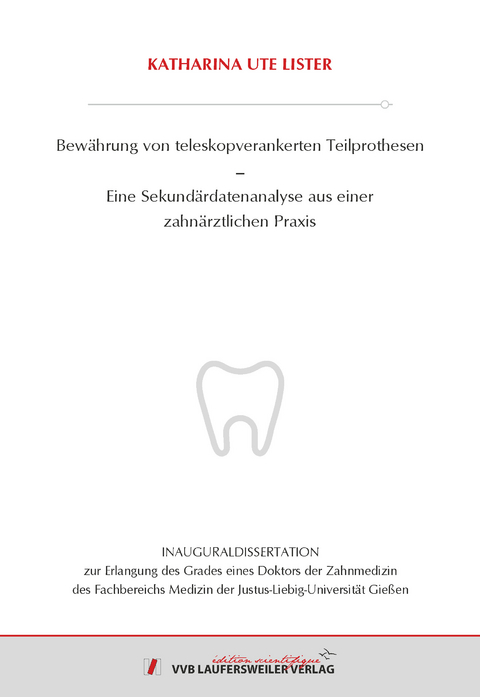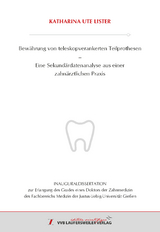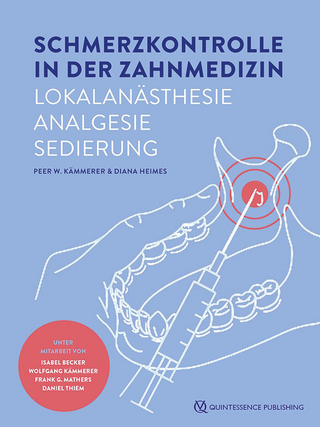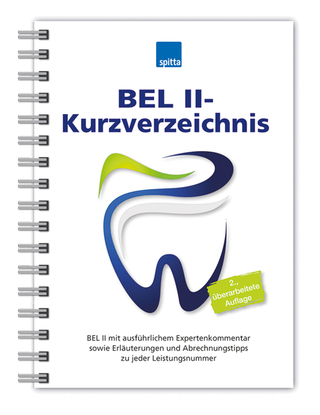Bewährung von teleskopverankerten Teilprothesen
Eine Sekundärdatenanalyse aus einer zahnärztlichen Praxis
Seiten
2022
VVB Laufersweiler Verlag
978-3-8359-7031-1 (ISBN)
VVB Laufersweiler Verlag
978-3-8359-7031-1 (ISBN)
- Keine Verlagsinformationen verfügbar
- Artikel merken
Die vorliegende retrospektive Studie beschäftigte sich mit der Fragestellung, inwiefern Teleskopprothesen, die in einer freien Zahnarztpraxis gefertigt wurden, mit Restaurationen aus universitären Zahnkliniken vergleichbar waren. Um dies zu ermöglichen, wurden die Prothesen und Pfeilerzähne hinsichtlich deren Langlebigkeit untersucht. Zusätzlich wurden Wiederherstellungsmaßnahmen analysiert und dokumentiert.
Zu Grunde lagen insgesamt 190 teleskopierende Versorgungen bei 149 Patienten, die auf 680 Pfeilerzähnen verankert waren. Es wurden verschiedene Einflussfaktoren auf das Überleben der Teleskopprothesen und der Pfeilerzähne untersucht. In Bezug auf die Wiederherstellungsmaßnahmen wurde die Art und das Datum der jeweiligen Intervention erfasst. Zur statistischen Überprüfung wurden die KAPLAN-MEIER-Analyse sowie die multiple Cox-Regression herangezogen. Wie oftmals in der Literatur beschrieben, wurde das Signifikanz-Niveau mit α ≤ 0,05 festgelegt.
Der mittlere Beobachtungszeitraum betrug 14,64 ± 0,5 Jahre. Währenddessen mussten 12,2% (n=23) aller Prothesen neuangefertigt werden. Die 5-/ 10- und 15-Jahresüberlebensraten lagen bei 96,2%, 78,4% sowie 60,4%. Als signifikanter Einfluss konnte die Gegenkieferbezahnung detektiert werden. Befand sich eine implantatgetragene Versorgung (Kategorie 4) im Gegenkiefer lag die mittlere Überlebenszeit bei 7,38 ± 0,0 Jahren. Dagegen belief sich das mittlere Überleben bei Gegenkiefern ohne prothetische Versorgung (Kategorie 5) auf 15,70 ± 1,15 Jahre. Die Cox-Regression ermittelte einen Anstieg für einen Funktionsverlust der zu untersuchenden Teleskopprothese um den Faktor 11,1, falls der Gegenkiefer eine implantatgetragene Restauration in situ hatte. Als weitere Einflussfaktor wurde die Anzahl der Pfeilerzähne ausfindig gemacht. Pro steigenden Pfeilerzahn sank das Verlustrisiko der jeweiligen Teleskopprothese um 31,5%.
Bei 83,2% aller untersuchten teleskopierenden Restaurationen war eine Wiederherstellungsmaßnahme notwendig. Die erste Intervention fand nach 3,13 ± 0,31 Jahren statt. Am häufigsten trat dabei das Rezementieren einer Primärkrone auf (31,6%); gefolgt von der Entfernung einer Druckstelle (20,9%) und dem Auffüllen eines Sekundär-Teleskops (10,1%). Weder die Gruppenvergleiche innerhalb der KAPLAN-MEIER-Analyse noch die Cox-Regression konnten einen signifikant beeinflussenden Parameter ausfindig machen.
Während des Beobachtungszeitraums mussten 115 (16,9%) der Pfeilerzähne extrahiert werden. Das mittlere Überleben belief sich auf 13,74 ± 0,29 Jahre. Die 5-/ 10- und 15-Jahresüberlebensraten betrugen 92,6%, 73,9% und 57,8%. Als beeinflussender Faktor konnte abermals die Gegenkieferbezahnung ausfindig gemacht werden. Es stellte sich ebenfalls heraus, dass implantatgetragener Zahnersatz im Gegenkiefer das Überleben eines Pfeilerzahnes signifikant verringerte. So lag dabei die mittlere Überlebenszeit bei 6,54 ± 0,45 Jahren. War dahingegen der Gegenkiefer nicht prothetisch versorgt, ergab das mittlere Überleben eine Dauer von 14,65 ± 0,58 Jahren und lag somit bei mehr als doppelt so lange. Auch die Cox-Regression unterstrich den negativen Einfluss von implantatgetragenen Restaurationen im Gegenkiefer. Sie fand heraus, dass das Verlustrisiko um ein 4,4-Faches anstieg. Im Gegensatz dazu sank das Risiko um 57,7%, wenn der Gegenkiefer keine prothetische Versorgung hatte. Neben der Gegenkieferbezahnung hatte die Zahngruppe, zu der ein Pfeilerzahn zuzuordnen war, einen signifikanten Einfluss auf dessen Funktionsdauer. Während die mittlere Überlebensdauer bei den Prämolaren 12,12 ± 0,57 Jahre betrug, belief sie sich bei den Molaren auf 16,36 ± 0,76 Jahre. Auch die Gegenüberstellung der 5-/ 10- und 15-Jahresüberlebensraten verdeutlichte die Überlegenheit der Molaren gegenüber den Prämolaren: 100%; 95,0% und 79,2% versus 86,5%; 66,3% und 46,9%.
Insgesamt stellte sich bei der Untersuchung heraus, dass Teleskopprothesen aus einer freien Zahnarztpraxis dieselben Outcome-Kriterien hatten, wie Prothesen aus Universitäts-Zahnkliniken. Somit war augenscheinlich ein vergleichbarer Standard während beiden Fertigungsprozessen gegeben. The present study addressed the question of the extent to which telescopic dentures fabricated in an independent dental practice were comparable with restorations from university dental clinics. To make this possible, the prostheses and abutment teeth were examined regarding their longevity. In addition, restoration measures were analyzed and documented.
The study was based on a total of 190 telescopic prostheses in 149 patients, which were anchored on 680 abutment teeth. Various factors influencing the survival of the telescopic prostheses and the abutment teeth were investigated. In relation to the restoration interventions, the type and date of each intervention was recorded. KAPLAN-MEIER analysis and multiple Cox regression were used for statistical testing. As often described in the literature, the significance level was set at α ≤ 0.05.
The mean observation period was 14.64 ± 0.5 years. During this time, 12.2% (n=23) of all prostheses had to be remade. The 5-/ 10- and 15-year survival probabilities were 96.2%, 78.4% and 60.4%, respectively. The opposing maxillary dentition could be detected as a significant influence. If an implant-supported restoration (category 4) was located in the opposing jaw, the mean survival time was 7.38 ± 0.0 years. In contrast, the mean survival for opposing jaws without prosthetic restoration (category 5) was 15.70 ± 1.15 years. Cox regression determined an increase for loss of function of the telescopic prosthesis under study by a factor of 11.1 if the opposing jaw had an implant-supported restauration in situ. The number of abutment teeth was found to be another influencing factor. For each increasing abutment tooth, the risk of loss of the respective telescopic prosthesis decreased by 31.5%.
Restorative intervention was necessary in 83.2% of all telescoping restorations examined. The first intervention took place after 3.13 ± 0.31 years. The most frequent intervention was the recementation of a primary crown (31.6%); followed by the removal of a pressure spot (20.9%) and the filling of a secondary telescope (10.1%). Neither the KAPLAN-MEIER analysis nor the Cox regression could detect a significantly influencing parameter.
During the observation period, 115 (16.9%) of the abutment teeth had to be extracted. The mean survival was 13.74 ± 0.29 years. The 5-/ 10- and 15-year survival probabilities were 92.6%, 73.9% and 57.8%, respectively. Once again, the opposing maxillary dentition was found to be an influencing factor. It was also found that implant-supported dentures in the opposing jaw significantly reduced the survival of an abutment tooth. The mean survival time was 6.54 ± 0.45 years. In contrast, if the opposing jaw was not prosthetically restored, the mean survival was 14.65 ± 0.58 years, which was more than twice as long. Cox regression also underscored the negative influence of implant-supported restorations in the opposing jaw. It found that the risk of loss increased by a factor of 4.4. In contrast, the risk decreased by 57.7%, if the opposing jaw had no prosthetic restoration. In addition to the opposing jaw dentition, the tooth group to which an abutment tooth was assigned had a significant effect. While the mean survival time for premolars was 12.12 ± 0.57 years, it was 16.36 ± 0.76 years for molars. Comparison of the 5-/ 10- and 15-year survival probabilities also highlighted the superiority of molars over premolars: 100%; 95.0% and 79.2% versus 86.5%; 66.3% and 46.9%.
Overall, the study showed that telescope prostheses from an independent dental practice had the same outcome criteria as prostheses from university dental clinics. Thus, a comparable standard was given during both manufacturing processes.
Zu Grunde lagen insgesamt 190 teleskopierende Versorgungen bei 149 Patienten, die auf 680 Pfeilerzähnen verankert waren. Es wurden verschiedene Einflussfaktoren auf das Überleben der Teleskopprothesen und der Pfeilerzähne untersucht. In Bezug auf die Wiederherstellungsmaßnahmen wurde die Art und das Datum der jeweiligen Intervention erfasst. Zur statistischen Überprüfung wurden die KAPLAN-MEIER-Analyse sowie die multiple Cox-Regression herangezogen. Wie oftmals in der Literatur beschrieben, wurde das Signifikanz-Niveau mit α ≤ 0,05 festgelegt.
Der mittlere Beobachtungszeitraum betrug 14,64 ± 0,5 Jahre. Währenddessen mussten 12,2% (n=23) aller Prothesen neuangefertigt werden. Die 5-/ 10- und 15-Jahresüberlebensraten lagen bei 96,2%, 78,4% sowie 60,4%. Als signifikanter Einfluss konnte die Gegenkieferbezahnung detektiert werden. Befand sich eine implantatgetragene Versorgung (Kategorie 4) im Gegenkiefer lag die mittlere Überlebenszeit bei 7,38 ± 0,0 Jahren. Dagegen belief sich das mittlere Überleben bei Gegenkiefern ohne prothetische Versorgung (Kategorie 5) auf 15,70 ± 1,15 Jahre. Die Cox-Regression ermittelte einen Anstieg für einen Funktionsverlust der zu untersuchenden Teleskopprothese um den Faktor 11,1, falls der Gegenkiefer eine implantatgetragene Restauration in situ hatte. Als weitere Einflussfaktor wurde die Anzahl der Pfeilerzähne ausfindig gemacht. Pro steigenden Pfeilerzahn sank das Verlustrisiko der jeweiligen Teleskopprothese um 31,5%.
Bei 83,2% aller untersuchten teleskopierenden Restaurationen war eine Wiederherstellungsmaßnahme notwendig. Die erste Intervention fand nach 3,13 ± 0,31 Jahren statt. Am häufigsten trat dabei das Rezementieren einer Primärkrone auf (31,6%); gefolgt von der Entfernung einer Druckstelle (20,9%) und dem Auffüllen eines Sekundär-Teleskops (10,1%). Weder die Gruppenvergleiche innerhalb der KAPLAN-MEIER-Analyse noch die Cox-Regression konnten einen signifikant beeinflussenden Parameter ausfindig machen.
Während des Beobachtungszeitraums mussten 115 (16,9%) der Pfeilerzähne extrahiert werden. Das mittlere Überleben belief sich auf 13,74 ± 0,29 Jahre. Die 5-/ 10- und 15-Jahresüberlebensraten betrugen 92,6%, 73,9% und 57,8%. Als beeinflussender Faktor konnte abermals die Gegenkieferbezahnung ausfindig gemacht werden. Es stellte sich ebenfalls heraus, dass implantatgetragener Zahnersatz im Gegenkiefer das Überleben eines Pfeilerzahnes signifikant verringerte. So lag dabei die mittlere Überlebenszeit bei 6,54 ± 0,45 Jahren. War dahingegen der Gegenkiefer nicht prothetisch versorgt, ergab das mittlere Überleben eine Dauer von 14,65 ± 0,58 Jahren und lag somit bei mehr als doppelt so lange. Auch die Cox-Regression unterstrich den negativen Einfluss von implantatgetragenen Restaurationen im Gegenkiefer. Sie fand heraus, dass das Verlustrisiko um ein 4,4-Faches anstieg. Im Gegensatz dazu sank das Risiko um 57,7%, wenn der Gegenkiefer keine prothetische Versorgung hatte. Neben der Gegenkieferbezahnung hatte die Zahngruppe, zu der ein Pfeilerzahn zuzuordnen war, einen signifikanten Einfluss auf dessen Funktionsdauer. Während die mittlere Überlebensdauer bei den Prämolaren 12,12 ± 0,57 Jahre betrug, belief sie sich bei den Molaren auf 16,36 ± 0,76 Jahre. Auch die Gegenüberstellung der 5-/ 10- und 15-Jahresüberlebensraten verdeutlichte die Überlegenheit der Molaren gegenüber den Prämolaren: 100%; 95,0% und 79,2% versus 86,5%; 66,3% und 46,9%.
Insgesamt stellte sich bei der Untersuchung heraus, dass Teleskopprothesen aus einer freien Zahnarztpraxis dieselben Outcome-Kriterien hatten, wie Prothesen aus Universitäts-Zahnkliniken. Somit war augenscheinlich ein vergleichbarer Standard während beiden Fertigungsprozessen gegeben. The present study addressed the question of the extent to which telescopic dentures fabricated in an independent dental practice were comparable with restorations from university dental clinics. To make this possible, the prostheses and abutment teeth were examined regarding their longevity. In addition, restoration measures were analyzed and documented.
The study was based on a total of 190 telescopic prostheses in 149 patients, which were anchored on 680 abutment teeth. Various factors influencing the survival of the telescopic prostheses and the abutment teeth were investigated. In relation to the restoration interventions, the type and date of each intervention was recorded. KAPLAN-MEIER analysis and multiple Cox regression were used for statistical testing. As often described in the literature, the significance level was set at α ≤ 0.05.
The mean observation period was 14.64 ± 0.5 years. During this time, 12.2% (n=23) of all prostheses had to be remade. The 5-/ 10- and 15-year survival probabilities were 96.2%, 78.4% and 60.4%, respectively. The opposing maxillary dentition could be detected as a significant influence. If an implant-supported restoration (category 4) was located in the opposing jaw, the mean survival time was 7.38 ± 0.0 years. In contrast, the mean survival for opposing jaws without prosthetic restoration (category 5) was 15.70 ± 1.15 years. Cox regression determined an increase for loss of function of the telescopic prosthesis under study by a factor of 11.1 if the opposing jaw had an implant-supported restauration in situ. The number of abutment teeth was found to be another influencing factor. For each increasing abutment tooth, the risk of loss of the respective telescopic prosthesis decreased by 31.5%.
Restorative intervention was necessary in 83.2% of all telescoping restorations examined. The first intervention took place after 3.13 ± 0.31 years. The most frequent intervention was the recementation of a primary crown (31.6%); followed by the removal of a pressure spot (20.9%) and the filling of a secondary telescope (10.1%). Neither the KAPLAN-MEIER analysis nor the Cox regression could detect a significantly influencing parameter.
During the observation period, 115 (16.9%) of the abutment teeth had to be extracted. The mean survival was 13.74 ± 0.29 years. The 5-/ 10- and 15-year survival probabilities were 92.6%, 73.9% and 57.8%, respectively. Once again, the opposing maxillary dentition was found to be an influencing factor. It was also found that implant-supported dentures in the opposing jaw significantly reduced the survival of an abutment tooth. The mean survival time was 6.54 ± 0.45 years. In contrast, if the opposing jaw was not prosthetically restored, the mean survival was 14.65 ± 0.58 years, which was more than twice as long. Cox regression also underscored the negative influence of implant-supported restorations in the opposing jaw. It found that the risk of loss increased by a factor of 4.4. In contrast, the risk decreased by 57.7%, if the opposing jaw had no prosthetic restoration. In addition to the opposing jaw dentition, the tooth group to which an abutment tooth was assigned had a significant effect. While the mean survival time for premolars was 12.12 ± 0.57 years, it was 16.36 ± 0.76 years for molars. Comparison of the 5-/ 10- and 15-year survival probabilities also highlighted the superiority of molars over premolars: 100%; 95.0% and 79.2% versus 86.5%; 66.3% and 46.9%.
Overall, the study showed that telescope prostheses from an independent dental practice had the same outcome criteria as prostheses from university dental clinics. Thus, a comparable standard was given during both manufacturing processes.
| Erscheinungsdatum | 25.04.2022 |
|---|---|
| Reihe/Serie | Edition Scientifique |
| Verlagsort | Gießen |
| Sprache | deutsch |
| Maße | 148 x 210 mm |
| Gewicht | 180 g |
| Themenwelt | Medizin / Pharmazie ► Zahnmedizin |
| Schlagworte | Dentalmedizin • Prothese • Teleskopverankerung |
| ISBN-10 | 3-8359-7031-3 / 3835970313 |
| ISBN-13 | 978-3-8359-7031-1 / 9783835970311 |
| Zustand | Neuware |
| Haben Sie eine Frage zum Produkt? |
Mehr entdecken
aus dem Bereich
aus dem Bereich
Buch | Spiralbindung (2023)
Asgard (Verlag)
40,00 €
Lokalanästhesie, Analgesie, Sedierung
Buch | Hardcover (2024)
QUINTESSENZ Verlag
88,00 €
BEL II mit ausführlichem Expertenkommentar sowie Erläuterungen und …
Buch | Spiralbindung (2023)
Spitta GmbH (Verlag)
159,43 €




